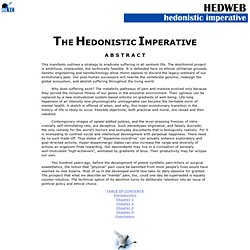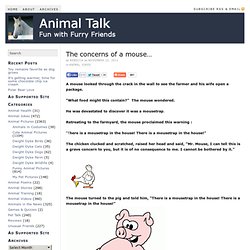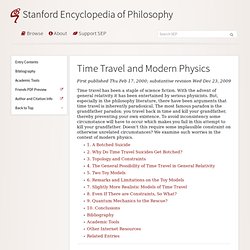

The Hedonistic Imperative - Abstract. This manifesto outlines a strategy to eradicate suffering in all sentient life.

The abolitionist project is ambitious, implausible, but technically feasible. It is defended here on ethical utilitarian grounds. Genetic engineering and nanotechnology allow Homo sapiens to discard the legacy-wetware of our evolutionary past. Our post-human successors will rewrite the vertebrate genome, redesign the global ecosystem, and abolish suffering throughout the living world. Why does suffering exist? Contemporary images of opiate-addled junkies, and the lever-pressing frenzies of intra-cranially self-stimulating rats, are deceptive. Two hundred years ago, before the development of potent synthetic pain-killers or surgical anaesthetics, the notion that "physical" pain could be banished from most people's lives would have seemed no less bizarre.
How Communism Works" In a perfect world, everyone would have food and shelter, and a true utopian society would be devoid of sexism, racism and other forms of oppression.

But for most of the world's population, this perfect society just isn't possible. Communism is one proposed solution to these problems. Most people know what communism is at its most basic level. Simply put, communism is the idea that everyone in a given society receives equal shares of the benefits derived from labor. Communism is designed to allow the poor to rise up and attain financial and social status equal to that of the middle-class landowners. According to the philosopher Frederick Engels' "Principles of Communism," the plan for ultimate financial and social equality is built on the principle that the system should spread around the world until all countries are on board [source: Engels].
Who are communists, and why do non-communist cultures consider them radical? The Socratic Method. The Socratic Method:Teaching by Asking Instead of by Tellingby Rick Garlikov The following is a transcript of a teaching experiment, using the Socratic method, with a regular third grade class in a suburban elementary school.

I present my perspective and views on the session, and on the Socratic method as a teaching tool, following the transcript. The class was conducted on a Friday afternoon beginning at 1:30, late in May, with about two weeks left in the school year. This time was purposely chosen as one of the most difficult times to entice and hold these children's concentration about a somewhat complex intellectual matter. The point was to demonstrate the power of the Socratic method for both teaching and also for getting students involved and excited about the material being taught. The experiment was to see whether I could teach these students binary arithmetic (arithmetic using only two numbers, 0 and 1) only by asking them questions. 1) "How many is this?
" 4) Another way? The concerns of a mouse… A mouse looked through the crack in the wall to see the farmer and his wife open a package.

“What food might this contain?” Time Travel and Modern Physics. First published Thu Feb 17, 2000; substantive revision Wed Dec 23, 2009 Time travel has been a staple of science fiction.

With the advent of general relativity it has been entertained by serious physicists. But, especially in the philosophy literature, there have been arguments that time travel is inherently paradoxical. The most famous paradox is the grandfather paradox: you travel back in time and kill your grandfather, thereby preventing your own existence. To avoid inconsistency some circumstance will have to occur which makes you fail in this attempt to kill your grandfather. 1.
You are very depressed. 2. The standard worry about time travel is that it allows one to go back and kill one's younger self and thereby create paradox. Well, one worry is the question as to why such schemes always fail. 3. Imagine the following set-up. However, it does not take much thought to realize that there is no paradox here. Let us now be more general and allow color photography. Figure 1 Figure 2. Dance, Monkeys, Dance. Philosoraptor Ponders 36 Crucial Lifeisms. Commencement Address. Critical thinking web. &Seven Blunders of the World& by Mahatma Gandhi - StumbleUpon. Table of contents. (With last update date) Cover Foreword (August 13, 2009) Part 1.

Quantum theory and consciousness Preface to part 1 (April 12, 2000)